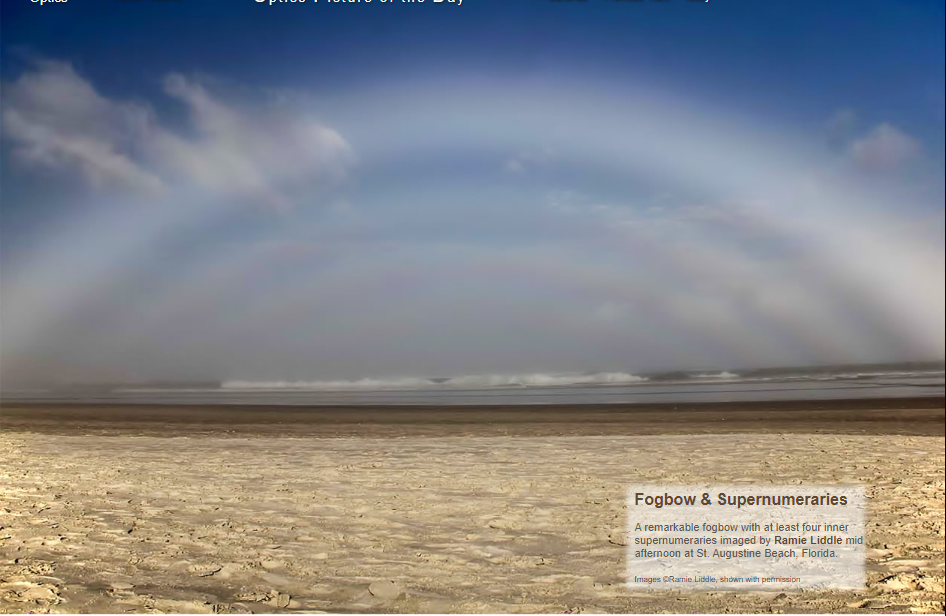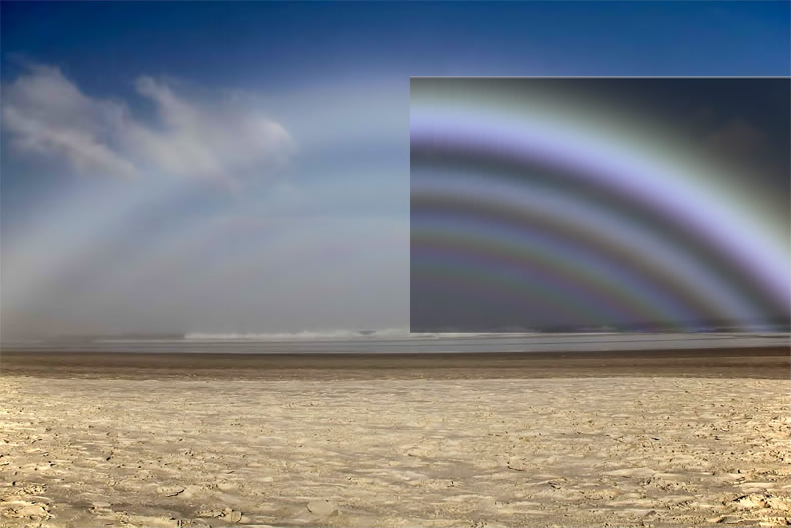Florida Fogbow, many Supernumeraries - OPOD
Florida Fogbow: A Stunning Atmospheric Phenomenon
Fogbows are captivating atmospheric optical phenomena that occur when sunlight interacts with tiny water droplets suspended in fog. These ethereal arcs resemble rainbows but have a more muted appearance due to the smaller size of the droplets involved. Recently, an incredible fogbow with multiple inner supernumeraries was captured by Ramie Liddle at St. Augustine Beach, Florida. The images of this phenomenon, which have been shared with permission, offer a mesmerizing glimpse into the intricacies of nature's light show.
The Enchanting Supernumeraries
Supernumeraries are additional faint bands of color that appear on the inside edge of the main fogbow. In the case of the Florida fogbow, there were at least four inner supernumeraries visible. What makes these supernumeraries particularly fascinating is their vibrant and intensified coloration compared to the main bow. While the main bow exhibits shades of red and straw colors on its outer side, the inner supernumeraries showcase a deeper red hue on their inner edges. This contrast adds an extra layer of visual allure to the overall spectacle.
Understanding the Science behind Fogbows
To comprehend the formation of fogbows and supernumeraries, we need to delve into the physics of light scattering and interference. Fog droplets, typically ranging in size from 1/20 mm to 1/100 mm, scatter sunlight in all directions. However, due to their smaller size compared to raindrops, fog droplets cause diffraction effects that result in a fogbow instead of a traditional rainbow. The supernumeraries arise from interference patterns produced by light waves diffracting around the droplets.
The Role of Droplet Size Distribution
The size distribution of the fog droplets plays a crucial role in determining the appearance of a fogbow and its supernumeraries. In the case of the Florida fogbow, the droplets exhibited a narrow size distribution, which contributed to the clarity and visibility of the inner supernumeraries. Interestingly, fogs tend to evolve from a narrow size distribution to a broader one over time. However, at St. Augustine Beach, the number of supernumeraries actually increased as the afternoon progressed, indicating a narrowing size spread. This phenomenon suggests the continuous formation and dissipation of fresh fog throughout the day.
The Impact of Droplet Size Variation
When fog droplets do not have a monosize distribution, the resulting fogbow may exhibit different characteristics. By introducing a 20% standard deviation in droplet size around the mean diameter, the distinct supernumerary fringe spacings become blurred and overlapped. Consequently, only the first supernumerary remains clearly visible while the subsequent ones lose their individuality. This example highlights the significance of droplet uniformity in determining the intricate details of a fogbow's appearance.
Appreciating the Beauty of Atmospheric Optics
The Florida fogbow with its multiple supernumeraries serves as a captivating reminder of the beauty and complexity of atmospheric optics. These phenomena offer us a glimpse into the intricate interplay between light, water droplets, and the atmosphere. By observing and studying these natural spectacles, we can deepen our understanding of the physics behind them and marvel at the wonders that surround us.
Conclusion
The Florida fogbow with its many supernumeraries is a visual delight that showcases the enchanting world of atmospheric optics. This captivating phenomenon, captured by Ramie Liddle at St. Augustine Beach, offers a unique opportunity to witness the interplay between sunlight and fog droplets. By exploring the science behind fogbows and understanding the impact of droplet size distribution, we can unravel the secrets behind these mesmerizing displays of nature's artistry. Let us continue to appreciate and marvel at the wonders that unfold above us in the ever-changing sky.

Fogbow & Supernumeraries
A remarkable fogbow with at least four inner supernumeraries imaged by Ramie Liddle mid afternoon at St. Augustine Beach, Florida.
Images ©Ramie Liddle, shown with permission

At left, an approximate fit to the fogbow by an IRIS Mie theory calculation. Monosized droplets with a diameter of 50 micron (1/20 mm) were used. Notice how the supernumeraries in the image and simulation have stronger colour than the main bow. Red is on the inside of the supernumeraries while reds and straw colours are on the outside of the main primary bow.
This fogbow was from droplets with a narrow size distribution in thin fog. Fogs tend to evolve from a narrow size distribution to a broad one. The St Augustine Beach was there all day. In the afternoon the number of supernumeraries actually increased with time indicating a narrowing size spread. Perhaps fresh fog was continually forming and burning away.

Below: What happens when the fog droplets are not monosize. At right the droplets have a 20% (standard deviation) distribution about the mean diameter of 50 micron. Different size droplets give different supernumerary fringe spacings and the resulting overlap blurs away the fringes. Only the first supernumerary is well seen.

Note: this article has been automatically converted from the old site and may not appear as intended. You can find the original article here.
Reference Atmospheric Optics
If you use any of the definitions, information, or data presented on Atmospheric Optics, please copy the link or reference below to properly credit us as the reference source. Thank you!
-
<a href="https://atoptics.co.uk/blog/florida-fogbow-many-supernumeraries-opod/">Florida Fogbow, many Supernumeraries - OPOD</a>
-
"Florida Fogbow, many Supernumeraries - OPOD". Atmospheric Optics. Accessed on November 26, 2024. https://atoptics.co.uk/blog/florida-fogbow-many-supernumeraries-opod/.
-
"Florida Fogbow, many Supernumeraries - OPOD". Atmospheric Optics, https://atoptics.co.uk/blog/florida-fogbow-many-supernumeraries-opod/. Accessed 26 November, 2024
-
Florida Fogbow, many Supernumeraries - OPOD. Atmospheric Optics. Retrieved from https://atoptics.co.uk/blog/florida-fogbow-many-supernumeraries-opod/.